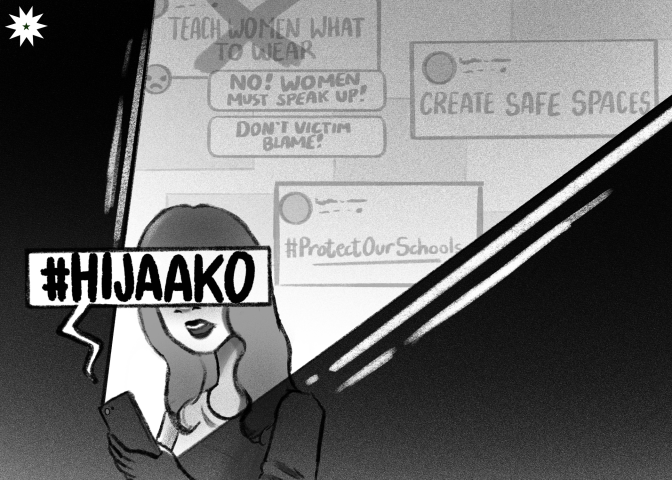Last June 11, the Lucban Municipal Police Station publicized what soon became a controversial Facebook post warning women and girls to “not wear short clothes” to prevent becoming victims of sexual assault crimes.
Among many others condemning the post for its perpetuation of rape culture, Frankie Pangilinan’s tweet, “Stop teaching girls how to dress? Teach people not to rape,” snagged media personality Ben Tulfo’s scornful response, “Hija, a rapist or a juvenile sex offender’s desire to commit a crime will always be there…You are inviting the beast.”
This stirred up the #HijaAko hashtag, perhaps what can be considered the localized #MeToo movement, infusing renewed energy into organizing and mobilizing against rape culture and sexual harassment. Over the past few weeks, more have emerged, such as #ProtectOurSchools and other contextualized, institution-specific petitions and campaigns.
One can also recall several sexual harassment cases involving Ateneo de Manila University faculty made rounds online in October of 2018 and 2019. In fact, one need not look that far to uncover more incidents: a DLSU faculty member accused of sexually harassing female students; more recently, a part-timer no longer continuing to teach at the University after his “closed-door session” post reacting to Sen. Risa Hontiveros’ condemnation of rape culture; and multiple harassment charges against a current student.
Additionally, reports surfaced last May 21 of checkpoint police officers abusing prostituted women in exchange for permitting them to cross quarantine borders.
Not just in the Philippines, but all over the world, a growing number of people are speaking up and baring their stories, their traumas, and their vulnerabilities. As more are finding the courage to share their experiences after years of grappling with these fears and pains alone, one thing becomes undeniably clear—a staggering proportion of the population have been harassed and assaulted in some way or form.
From objectification and beauty standards, to fragile egos and misogyny, this culture of rape and victim blaming is a sinister pervasion inducing physical and psychological anguish. Abuse can be perpetuated anywhere—be it the school, the workplace, on the commute, at a mall, or even at home. Those who belong to disadvantaged and minority groups face even greater risk of sexual violence.
Online, many are finding the platform a useful way to add their voice to the movement, breathing their narratives into calls for action. But the escalating hyperfixation also means much vulnerability. Social media is far from being a safe space; it is much too open and unregulated, with some users not any less vile than perpetrators themselves. Degradation is disastrously common; many discredit the victims, such as when these incriminate influential people like celebrities, and belittle what pain and devastating consequences they have gone through.
If all these revelations are not ringing alarm bells, then what will? For so long, assault victims have been disparaged. They are silenced; they are invalidated; they are detested when they come forward, as if being violated the first time was not enough. They may even be subjected to more violence and injustice.
It should be stressed that they disclose these horrid experiences, not just for the sake of doing so, but because they demand change. Many of the people involved, as well as any other marginalized group, are activists by necessity. They need to do it, because the existing systems will not do it for them and will likely not adequately support them.
Victims must be guided—not on how to dress “conservatively” or how to avoid “tempting” unwanted advances—but on how to press charges, and on who they can turn to for help with processing traumatic experiences. Resources must be made accessible, providing proper legal and psychological support.
However, individualistic responses like these are far from sufficient, because the burden of responsibility still ends up falling on the assaulted rather than the assailant and the larger systemic issue.
Aside from aiding victims after the fact, humanity must do more to prevent such abhorrent crimes from being committed in the first place. What used to be written off as “harmless” remarks can no longer be let slide. The notion that these are insignificant is precisely why such deplorable beliefs have been allowed to persist until now, and is exactly why such lines of thinking must be demolished completely. Instead, inculcate that explicit consent is a mandatory imperative, that bodies are not objects, that no one should ever be coerced or even made to feel obligated to satisfy another’s urges—simply put, to not rape.
An effort to educate and change viewpoints, the Philippine National Police’s Women and Children Protection Center posted, “Ito ay dress. Hindi ito yes,” last June 24. It is a start, and a necessary one at that, but it is not enough.
(This is a dress, not a yes.)
Institutions and societal structures—such as the government, the academe, the workplace—must be decisive and willing to do the revolutionary shattering themselves, moving beyond “we hear your stories” to “we will take concrete steps to create safer spaces.” This implicates making aptly firm decisions and following through on policies; terminating and punishing, not tolerating, offenders.
Centuries’ worth of implanted misogynistic perceptions may not be dismantled in one night nor by one statement. It would require comprehensive, persistent, and deliberate efforts built on conscious changes on several fronts to drive a larger institutional, even societal transformation.

